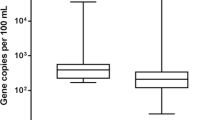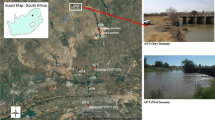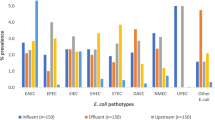Abstract
A total of 285 water samples were collected from 71 roof harvested rainwater tanks from four villages in different provinces over a two-year (2013–2014) period during the early (October to December) and late (January to March) rainy season. Water quality was evaluated based on Escherichia coli, faecal coliforms and Enterococcus spp. prevalence using the IDEXX Quanti-Tray quantification system. Real-Time PCR was used to analyse a subset of 168 samples for the presence of Shigella spp., Salmonella spp. and E. coli virulence genes (stx1, stx2 and eaeA). Escherichia coli were detected in 44.1% of the samples, Enterococcus spp. in 57.9% and faecal coliforms in 95.7%. The most prevalent E. coli concentrations in harvested rainwater were observed in 29.1% of samples and 22.5% for Enterococcus spp. and, were within 1–10 cfu/100 ml and 10–100 cfu/100 ml, respectively, whereas those for faecal coliforms (36.6%) were within 100–1000 cfu/100 ml. On average 16.8% of the samples had neither E. coli nor Enterococcus spp. detected, while 33.9% had only Enterococcus spp. and 23.7% had only E. coli. E. coli and Enterococcus spp. were detected together in 25.5% of the samples. Evaluation of samples for potential pathogenic bacteria showed all tested samples to be negative for the Shigella spp. ipaH gene, while five tested positive for Salmonella ipaB gene. None of the samples tested positive for the stx1 and stx2 genes, and only two tested positive for the eaeA gene. These findings are potentially useful in the development of a simplified risk assessment strategy based on the concentrations of indicator bacteria.
Similar content being viewed by others
References
Ahmed, W., Huygens, F., Goonetilleke, A., & Gardner, T. (2008). Real-time PCR detection of pathogenic microorganisms in roof-harvested rainwater in Southeast Queensland, Australia. Applied and Environmental Microbiology, 74(17), 5490–5496.
Ahmed, W., Goonetilleke, A., & Gardner, T. (2010a). Implications of faecal indicator bacteria for the microbiological assessment of roof-harvested rainwater quality in Southeast Queensland, Australia. Canadian Journal of Microbiology, 56(6), 471–479.
Ahmed, W., Vieritz, A., Goonetilleke, A., & Gardner, T. (2010b). Health risk from potable and non-potable uses of roof-harvested rainwater in Australia using quantitative microbial risk assessment. Applied and Environmental Microbiology, 76, 7382–7391.
Ahmed, W., Gardner, T., & Toze, S. (2011a). Microbiological quality of roof-harvested rainwater and health risks: a review. Journal of Environmental Quality, 40(1), 13–21.
Ahmed, W., Hodgers, L., Masters, N., Sidhu, J. P. S., Katouli, M., & Toze, S. (2011b). Occurrence of intestinal and extra-intestinal virulence genes in Escherichia coli isolates from rainwater tanks in Southeast Queensland, Australia. Applied and Environmental Microbiology, 77, 7394–7400.
Chidamba, L., & Korsten, L. (2015). A scoping study on the prevalence of Escherichia coli and enterococcus species in harvested rainwater stored in tanks. Water SA, 41(4), 501–508.
Clewell, D.B., Gilmore, M.S., Ike, Y., & Shankar, N. eds. (2014). Enterococci: from commensals to leading causes of drug resistant infection. Massachusetts Eye and Ear Infirmary: https://www.ncbi.nlm.nih.gov/books/NBK190424/. 30 Accessed Jan 2018.
Edberg, S. C. L., Rice, E. W., Karlin, R. J., & Allen, M. J. (2000). Escherichia coli: the best biological drinking water indicator for public health protection. Journal of Applied Microbiology, 88, 106S–116S.
Evans, C. A., Coombes, P. J., Dunstan, R., Harrison, T., Martin, A., & Harris, J. N. (2006). Coliforms, biofilms, microbial diversity and the quality of roof-harvested rainwater. Water Research, 40(1), 34–44.
Girones, R., Ferrus, M. A., Alonso, J. L., Rodriguez-Manzano, J., Calgua, B., de Abreu Corrêa, A., & Bofill-Mas, S. (2010). Molecular detection of pathogens in water–the pros and cons of molecular techniques. Water Research, 44(15), 4325–4339.
Hamilton, K. A., Ahmed, W., Palmer, A., Sidhu, J. P. S., Hodgers, L., Toze, S., & Haas, C. N. (2016). Public health implications of Acanthaba and multiple potential opportunistic pathogens in roof-harvested rainwater tanks. Environmental Research, 150, 320–327.
Hamilton, K. A., Ahmed, W., Palmer, A., Smith, K., Toze, S., & Haas, C. N. (2017). Seasonal assessment of opportunistic premise plumbing pathogens in roof-harvested rainwater tanks. Environmental Science and Technology, 51(3), 1742–1753.
Ksoll, W. B., Ishii, S., Sadowsky, M. J., & Hicks, R. E. (2007). Presence and sources of faecal coliform bacteria in epilithic periphyton communities of Lake Superior. Applied and Environmental Microbiology, 73, 3771–3778.
Kus, B., Kandasamy, J., Vigneswaran, S., & Shon, H. K. (2010). Water quality characterisation of rainwater in tanks at different times and locations. Water Science and Technology, 61(2), 429–439.
Lyautey, E., Lu, Z., Lapen, D. R., Wilkes, G., Scott, A., Berkers, T., Edge, T. A., & Topp, E. (2010). Distribution and diversity of Escherichia coli populations in the south Nation River drainage basin, Eastern Ontario, Canada. Applied and Environmental Microbiology, 76, 1486–1496.
Meera, V., & Ahammed, M. M. (2006). Water quality of rooftop rainwater harvesting systems: a review. Journal of Water Supply: Research and Technology-AQUA, 55(4), 257–268.
Müller, D., Greune, L., Heusipp, G., Karch, H., Fruth, A., Tschäpe, H., & Schmidt, M. A. (2007). Identification of unconventional intestinal pathogenic Escherichia coli isolates expressing intermediate virulence factor profiles by using a novel single-step multiplex PCR. Applied and Environmental Microbiology, 73(10), 3380–3390.
Savichtcheva, O., & Okabe, S. (2007). Alternative indicators of fecal pollution: relations with pathogens and conventional indicators, current methodologies for direct pathogen monitoring and future application perspectives. Water Research, 40(13), 2463–2476.
Sazakli, E., Alexopoulos, A., & Leotsinidis, M. (2007). Rainwater harvesting, quality assessment and utilization in Kefalonia Island, Greece. Water Research, 41(9), 2039–2047.
Spinks, J., Phillips, S., Robinson, P., & Van Buynder, P. (2006). Bushfires and tank rainwater quality: A cause for concern? Journal of Water and Health, 4(1), 21–28.
World Health Organization. (1996). Guidelines for drinking water quality: health criteria and other supporting information (2nd ed.). Geneva: World Health Organization.
World Health Organization. (2004). Guidelines for drinking water quality, volume 1 recommendations. Geneva: World Health Organisation.
Yaziz, M. I., Gunting, H., Sapari, N., & Ghazali, A. W. (1989). Variations in rainwater quality from roof catchments. Water Research, 23(6), 761–765.
Acknowledgements
This study was undertaken as part of a Water Research Commission (WRC) unsolicited project: “Evaluation of the risks associated with the use of rainwater harvested from roofs, for domestic use and, homestead food gardens; and groundwater for domestic use and livestock watering” (WRC Project No K5/2175, Water Research Commission, 2013).
Author information
Authors and Affiliations
Corresponding author
Rights and permissions
About this article
Cite this article
Chidamba, L., Korsten, L. Relative proportions of E. coli and Enterococcus spp. may be a good indicator of potential health risks associated with the use of roof harvested rainwater stored in tanks. Environ Monit Assess 190, 177 (2018). https://doi.org/10.1007/s10661-018-6554-1
Received:
Accepted:
Published:
DOI: https://doi.org/10.1007/s10661-018-6554-1




